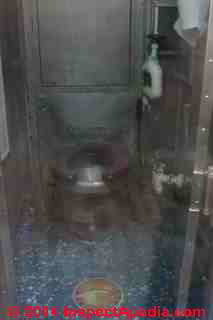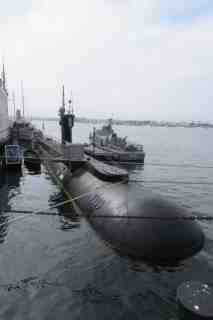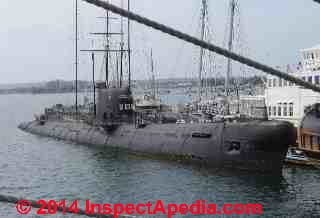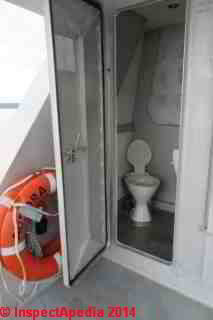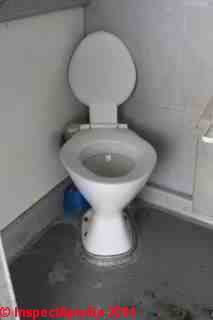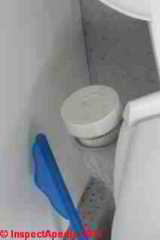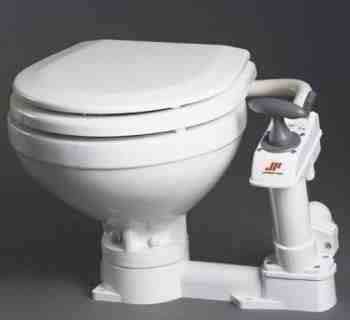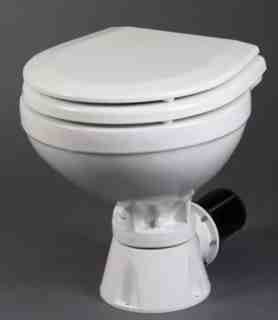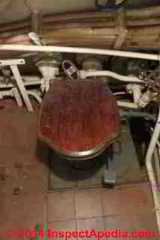 Marine Toilets - Heads - Морские Туалеты
Marine Toilets - Heads - Морские Туалеты
Examples & sources of toilets used on boats, ships, submarines: current & historical including the Soviet b-39 and the U.S.S. Dolphin
- POST a QUESTION or COMMENT about marine toilets
 Marine toilets - toilet facilities for boats (heads): this article describes marine toilets, beginning with some history and photographs of toilets use on the b-39, a Russian submarine (photo at page top) and the U.S.S. Dolphin, an Amerian research submarine.
Marine toilets - toilet facilities for boats (heads): this article describes marine toilets, beginning with some history and photographs of toilets use on the b-39, a Russian submarine (photo at page top) and the U.S.S. Dolphin, an Amerian research submarine.
We include references to marine toilet suppliers, products, history, and designs.
 Морские туалеты - туалет для лодок: эта статья описывает морские туалеты, начиная с некоторого истории с фотографиями туалетов использовать на B-39, русской подводной лодки (фото на странице вверху) и USS Дельфин, Amerian исследования подводной лодки. Мы включать ссылки на морской туалет поставщиков, продукции, истории и конструкций.
Морские туалеты - туалет для лодок: эта статья описывает морские туалеты, начиная с некоторого истории с фотографиями туалетов использовать на B-39, русской подводной лодки (фото на странице вверху) и USS Дельфин, Amerian исследования подводной лодки. Мы включать ссылки на морской туалет поставщиков, продукции, истории и конструкций.
InspectAPedia tolerates no conflicts of interest. We have no relationship with advertisers, products, or services discussed at this website.
- Daniel Friedman, Publisher/Editor/Author - See WHO ARE WE?
Marine Toilets Used on Boats, Submarines, Other Sea Vessels
 at left and then below we illustrate two pump type toilets (туалеты in Russian) used aboard two submarines. At left is one of three toilets installed on the b-39, commissioned in 1974 and decomissioned in 1994.
at left and then below we illustrate two pump type toilets (туалеты in Russian) used aboard two submarines. At left is one of three toilets installed on the b-39, commissioned in 1974 and decomissioned in 1994.
This boat, a widely-respected diesel-electric submarine, was part of the 9th Submarine Squadron based in Vldivostok. It carried a crew of nine officers and as many as 56 enlisted men. The toilet operated by a combination of air and water pressure - you can see a foot pump in the photo's foreground.
В ниже уехали, мы иллюстрируют два типа насоса туалеты (туалеты на русском языке) используется на борту двух подводных лодок. Слева является одним из трех туалетов, установленных на B-39, введенных в эксплуатацию в 1974 году и decomissioned в 1994 году.
Эта лодка, широко уважаемым дизель-электрическая подводная лодка, был частью 9-го эскадры подводных лодок, базирующейся в Vldivostok. Это имел экипаж из девяти офицеров и столько, сколько 56 рядовых. Туалет управляется сочетанием воздуха и давления воды - вы можете увидеть ножной насос на переднем плане в фотографии.
[Click to enlarge any image]
Origin of "the Head" term describing marine toilets
Much earlier than the modern seagoing vessel and submarine toilet facilities illustrated below, on sailing ships toilets consisted principally of a rectangular box or "head" (placed near the bow of the vessel near hull or deck level) designed to dispose of sewage waste by bow-wave action. A more private toilet facility was provided for the captain in quarters nearer to the ship's stern.
Development of & Types of Marine Toilets
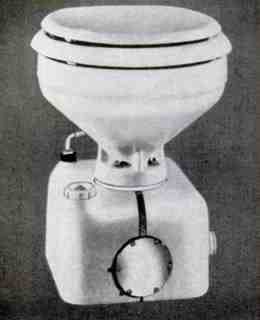 While those earlier seagoing toilet facilities involved thoughtful design (cleaning the toilet by wave action), on more modern ships toilets usually flush by use of a combination of water pressure and on occasion air pressure. Marine toilet pumps may be operated by hand (smaller boats) or by electricity, or by electricity and compressed air.
While those earlier seagoing toilet facilities involved thoughtful design (cleaning the toilet by wave action), on more modern ships toilets usually flush by use of a combination of water pressure and on occasion air pressure. Marine toilet pumps may be operated by hand (smaller boats) or by electricity, or by electricity and compressed air.
Pump-operated marine toilet history and anecdotes include problems with clogging. But as Schobe (2003) and others have pointed out, space and the ratio of numbers of toilets and its relation to crew size are also important considerations that extend beyond convenience to health.
In North America by the late 1960's changes in marine sanitation law prohibited the discharge of raw sewage into waterways, leading to both development and installation of a variety of types of marine toilets including macerator-chlorinator systems and an early application of the Destroilet invented by Frank J. La Mere.
At left: the Raritan Crown Head macerating toilet could also accept galley waste. Popular Mechanics, December 1968.
[Click to enlarge any image]
Lee Oertle's "Plan A Head", New boat laws may force you to change your marine toilet. Here's a rundown on the four basic sanitation systems now available", an article in the December 1988 issue of Popular Mechanics Magazine, described several toilet systems that might be suitable for marine application and one still in active use but soon to be prohibited including:
- Macerator-chlorinator toilets for marine use: the waste is mechanically broken up by a sewage grinder pump, chlorine is added, and the "treated waste" is discharged overboard. Macerating-chlorinating toilets might either be designed to dump sewage overboard or to store it in a holding tank for dockside disposal at a dumping stataion.
Our opinion is that the level of chlorination for these systems including dose strength, exposure time, and degree of maceration may have made this approach less than fully reliable when dumping overboard and other issues might have arisen if the dockside sewage receiving station were expected to treat and dispos of sewage using a conventional septic system. Oertle (1968) pointed out that some industry experts noted that sewage dumping station operators themselves may have simply been dumping their accepted sewage back into the waterway!
Examples: the Kohler Dayton macerating chlorinating toilet. This was an add-on product designed to be attached to the existing head (toilet) in marine vessels. The Apollco macerating toilet included an automatic chlorine (bleach) dispensing feature. The Raritan regular flush toilet could be connected to an add-on chlorinator/grinder for waste treatment or dumping, and the Raritan Crown Head could also accept garbage and galley waste. - Recirculating toilets for marine use: a filtration system is used to remove solid waste while flush water is filtered and re-used.
Example: The Corlon Commander 9-gallon recirculating toilet with a built-in discharge pump. Monomatic toilet. Some recirculating toilet models included a sewage grinder along with a discharge pump to permit emptying of ground, treated waste into a sewage dumping station when the boat was at dockside. These tanks could also be discharged into any conventional (land-side) toilet that was reach-able, though we re-state our warning above that discharge of disinfected or treated waste into a conventional septic system in volume may damage the system by killing off septic tank bacteria.
See RV HOLDING TANK DUMP INTO SEPTIC TANK? - Holding-tank toilet systems for marine use: sewage is held in a storage tank to be emptied at a sewage dumping station when the vessel is docked. This approach could be adapted to existing marine toilets, but space limitations may have limited this solution for smaller boats.
- Incinerating toilet systems for marine use: sewage including wastewater is incinerated using a burner fueled by propane or possibly adapted for use with other fuels that may have been at hand, such as diesel.
See INCINERATOR TOILET SYSTEMS. - Poop and Dump toilet systems for marine use: dating from prehistoric times with the head that we described above, sewage was dumped out of the vessel directly into the waterway. Early vessels used a hole in the hull as a toilet, usually at the bow or stern, while 20th century vessells would more typically have used water, possibly seawater, to flush the toilet directly overboard.
By 1968 in the U.S. state and federal laws prohibited direct discharge of sewage into most waterways at least within coastal limits.
In his 1968 Popular Mecanics article Oertle illustrated the following marine toilets operating on these principles: the Corlon Commander recirculating toilet unit, Koehler-Dayton macerator-chlorinating toilet, the Raritan chlorinator flush unit, the Raritan Crown Head sewage grinder/chlorinator toilet, and the "Destroilet" described as a "self contained incinerating combustion unit operating on LP gas and electricity."
Submarine Toilets
Submarine toilets have always faced special techical problems since we cannot simply use gravity or a low-powered pump to dispose of sewage into the waterway when the submarine is suberged. Further, sanitation in an enclosed and densly occupied space becomes particularly important if a crew is to be kept healthy and functional.
Aboard the b-39 submarine (toilet shown at above left), the San Diego Maritime Museum's documents explain, with so many people aboard, lingering in the toilet facility was "tantamount to a crime".
Above (unfortunately photographed through a plexiglass barrier to keep tourists from peeing where they should not) is a similar on-board toilet installed on the U.S.S. Dolphin, an American research submarine launched in 1968 and decommissioned in 2007.
This famous sub made a dive to a depth of 3000 ft. early in its career, and was the last U.S. diesel-electric submarine. The Dolphin carried a much smaller crew aboard: 3 officers, 18 enlisted men and 4 scientists for a total of 25 people.
В выше справа такая же бортовой туалет установлен на USS Дельфин, американский исследования подводной лодки запущен в 1968 году и выведен из эксплуатации в 2007 году.
Эта знаменитая суб сделал погружение на глубину 3000 футов в начале своей карьеры, и был последним США дизель-электрическая подводная лодка.Дельфин осуществляется гораздо меньшим числом членов экипажа на борту: 3 офицеров, 18 солдат и 4 ученых в общей сложности 25 человек.
Perhaps if the Russian and American submariners shared toilet facilities side-by-side as I've placed these photos, the cold war may have ended sooner.
Возможно, если бы российские и американские подводники общий туалет бок о бок, как я разместил эти фотографии, холодная война, возможно, закончился раньше.
At above left is the U.S. Dolphin research submarine. Shown at above right is the b-39 Soviet submarine docked at the Maritime Museum of San Diego. The b-39 was photographed from the deck of the much older Star of India. After its decomissioning in 1994 the b-39 was sold to a group of Canadian businessmen for its new life as an exhibition boat.
В выше слева является исследование американская подводная лодка Дельфин. Указаны координаты на выше права является б-39 советская подводная лодка заход в Морской музей Сан-Диего.Б-39 был сфотографирован с палубы гораздо старше Звезды Индии. После его Завершение эксплуатации в 1994 году б-39 был продан группой канадских бизнесменов своей новой жизни в качестве выставочного лодке.
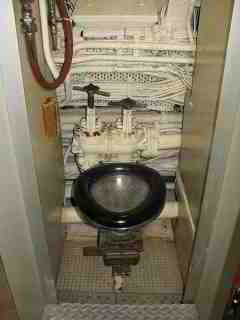 These boats can be visited at the Maritime Museum of San Diego California, an institution that also provides historic information about these and other important and interesting boats, ships, ferries and related craft.
These boats can be visited at the Maritime Museum of San Diego California, an institution that also provides historic information about these and other important and interesting boats, ships, ferries and related craft.
- Maritime Museum of San Diego, Maritime Museum of San Diego, 1492 North Harbor Drive San Diego, CA 92101, Tel: 619-234-9153, Email: info@sdmaritime.org Website: http://www.sdmaritime.org/
- Морской музей Сан-Диего, Морской музей Сан-Диего, 1492 North Harbor Drive, San Diego, CA 92101, Tel: 619-234-9153, Email: info@sdmaritime.org Website: http://www.sdmaritime.org/
Shown at left is a marine toilet or "head" aboard the HMS Alliance submarine - Wikipedia, 4/28/14, original source: http://en.wikipedia.org/wiki/File:Heads_on_HMS_alliance.jpg
The HMS Alliance (P417), a British Royal Navy A-class (Acheron) diesel-electric submarine was completed in 1947 and has served as a memorial and museum ship since 1981.
The Alliance was designed for use in the Pacific Ocean and intended to support long partrols that included submerged passages of up to 36 hours. This boat, at 281 feet, is larger than the other vessels described in this article. - Wikipedia & Royal Navy citations below
Question: what about using a porta-john on a boat - isn't high temperature a worry?
This question was originally posted at CHEMICAL TOILETS: 4/23/14 Anonymous said:
How do you avoid high heat on a boat?, and should I be worried about this?
Reply: No if proper chemical treatment is used, otherwise yes heat is a concern with some portable toilets & some fixed, waterless incinerating toilets
Anon,
If you are asking about flush-toilets used on boats without a waste holding tank, heat should not be an issue regardless of whether the toilet flushes by manual or electric pump. Some equipment may be damaged by freezing however, as we cite below.
If you are asking about a chemical toilet for boat use, in normal use the addition of odor control treatment chemicals to the toilet base should prevent troublesome methane gas formation at problem levels by controlling the amount of bacterial action - basically stopping it. See HOW TO ADD CHEMICAL DEODORANT / DISINFECTANT to a chemical toilet
Watch out: if someone omits the recommended chemical toilet treatment, then it is possible that some models may use a holding tank that is too air-tight, un-vented, that could result in a toilet explosion. Check with the product manufacturer to make sure that the model about which you inquire is rated for high temperature locations and marine use.
At CAMPING & EMERGENCY TOILETS I describe a real-world worry about harmful explosions that can occur if un-treated sewage waste is kept in a tightly sealed container and exposed to high temperatures.
Watch out: If you are asking about an incinerating toilet, you should definitely be worried about high heat. The electric incinerating toilet I found reported as for boat use (and possibly 12V) (INCINERATOR TOILET SYSTEMS) not only uses a lot of current that may be a problem on small craft, but it was an older, used unit. I could not find a current electric incinerating toilet for boat use from the manufacturer - which is not to say it doesn't exist, but I sure couldn't find one.
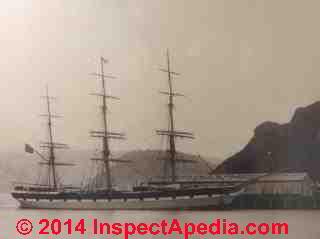 In April of 2014 toured the b-39 , a Soviet submarine docked at the Maritime Museum of San Diego where among other details one can note the submarine toilet design and use. I illustrate these respected boats in the article above. The flushing of the toilets on these subs was pump operated with a mix of air and water.
In April of 2014 toured the b-39 , a Soviet submarine docked at the Maritime Museum of San Diego where among other details one can note the submarine toilet design and use. I illustrate these respected boats in the article above. The flushing of the toilets on these subs was pump operated with a mix of air and water.
Toilet facilities on much older craft ranged from nothing - hanging out over a rail or bowsprit - to an open commode seat in the transom or aft section of the ship.
Until I can find more current information I don't recommend picking up an incinerating toilet for boat use (unless maybe you're sailing on the all-steel Star of India - on second thought not even there).
At above left we include a photograph of the Star of India in 1880-1890 when she sailed under her original name, the Euterpe. Here the Euterpe was docked at the Shaw Savill Wharf at Port Chalmers in New Zealand. In her second life (of many) as an emigrant transport ship, the Euterpe the ship sailed between Britain and Australia and New Zealand, delivering roughly 450 emigrants to those countries. - source: Maritime Museum of San Diego, DF 4/2014
In a discussion of marine toilets it's noteworthy that so many people crowded aboard a roughly 220 ft. ship also had to do with crowding conditions reflected a century later in our discussion of toilets aboard the Soviet b-39.
Besides the two submarines the b-39 and the Dolphin, and the Star of India (nee Euterpe), among its large collection of intersting boats the Maritime Museum of San Diego includes the HMS Surprise, the huge steam-driven Berkeley ferryboat, the steam yacht Medea, Swift Boat, Pilot, the Californian, the America, the Stars and Stripes, and the Abracadabra.
В выше слева мы включаем фотографию Звезды Индии в 1880-1890, когда она плыла под ее оригинальным названием, в Эвтерпа. Здесь Эвтерпа был пристыкован в Шоу Savill Wharf в Порт Чалмерс в Новой Зеландии. В ее второй жизни (многих) в качестве эмигранта транспортный корабль, Эвтерпа корабль плыл между Великобританией и Австралией и Новой Зеландией, обеспечивая примерно 450 эмигрантов в эти страны. - Источник: Морской музей Сан-Диего, DF 4/2014
При обсуждении морских туалетов стоит отметить, что так много людей толпились на борту примерно 220 футов корабля также было связано с условиями краудинга отражается столетие спустя в нашем обсуждении туалетов на борту советского б-39.
- Maritime Museum of San Diego, 1492 North Harbor Drive San Diego, CA 92101, Tel: 619-234-9153, Email: info@sdmaritime.org Website: http://www.sdmaritime.org/
For toilets left on boats stored in freezing conditions see FREEZE PROTECTION for PORTABLE TOILETS
Incinerating Toilets Used on Boats ?

As we explained at INCINERATOR TOILET SYSTEMS, the Incinolet toilets draw electricity (120V or 240V for some models) only when the toilet is in use, unlike some composting toilets where electricity may be needed at all times, even during "off seasons" since the composting toilet unit includes a heater and ventilation fan.
Electrical consumption for these components will be much less than that used during an incineration cycle.
Although incinolet model specifiations are not readily accessible on the company's website, we have seen a Marine version of this incinerating toilet, the Incinolet Model WB / TR-III listed as a Type III MSD Certified toilet for use on inspected & uninspected vessels.
Really? we were not able to find contemporary (April 2014) descriptions indicating this product is actively being marketed for marine use. Check with the manufacturer.
- Incinolet Contact Information: Research Products/Blankenship, 2639 Andjon, Dallas, Texas 75220, USA, Tel: 800-527-5551 Email: sales@incinolet.com, Website http://www.incinolet.com/ - The company has produced this incinerating toilet for more than 40 years.
Modern Marine Toilets on Surface Vessels
So what do toilets look like on boats that don't have to manuver under water? Here we illustrate several examples.
At above left, a back-flush toilet opeated by a gravity-cistern on a passenger cruiser in New Zealand. At above right, aboard the ferry Aurora that operates between South Island and Steward Island in New Zealand we see a marine toilet in the head - which is no longer located in the head of the ship.
Below are additional details of this marine toilet.
Marine Toilet Resources: where to buy a toilet for a boat
Below we illustrate two contemporary marine toilet examples, the Johnson AquaT manual pump marine toilet and the Johnson AquaT electric flush marine toilet. Contact information for the company and for other marine toilet suppliers is given below. Generally you'll also find toilets from these manufacturers distributed by marine supply companies.
- Jabsco 12-Volt Electric Marine Toilet, fused at 25A, china bowl, impeller-operated flush pump, can be mounted up to a meter below the waterline. Complies with USCG 183.410 and ISO 8846 MARINE (Ignition Protection).
- Johnson AquaT compact manual marine toilet, hand pump operated.
- SeaLand Toilets from Dometic, e.g. the Sealand 510H, 17"high, china bowl, low water usage or the Sealand 711 M28 Marine Sanitation toilet (including a holding tank) flushing with fresh water.
- Thetford 41160 Comfortmate Maunal Pump Marine Toilet, a permanently-installed unit, not a portable unit like some other Thetford toilets we discuss at CHEMICAL TOILETS. Thetford produces a range of marine toilets in various sizes, capacitis, and features.
Regulations on Marine Toilets & Sewage Disposal in Waterways or At Sea
U.S. Regulations on Marine Sewage Devices
The U.S. Coast Guard (U.S. Department of Homeland Security) Systems Engineering Division (CG-ENG-3) publishes information about marine sanitation from which we excerpt:
These regulations are divided into three sections covering acceptance of laboratories that examine, inspect, and test MSDs, certification of equipment, and requirements for a vessel to have an MSD.
- The USCG notes that for the United States each Code of Federal Regulation (CFR) is updated annually in a free, searchable database available from Marine Sanitation Device - http://www.uscg.mil/hq/cg5/cg5213/msd.asp
International Convention for Prevention of Pollution From Ships - MARPOL 73/78
This regulation, which admits of voluntary compliance for U.S. Vessels (see USCG information above) is intended to minimize pollution of the oceans and covers a variety of contaminants including oil, exhaust, fuels, and "noxious liquid substances", harmful packaged substances, sewage, garbage, and air pollution. The scope of pollutant environments include air, water and soil and also specifically addresses radioactive contamination and lists international agreements in these matters in an extensive list by treaty and country.
- Annex IV of MARPOL 73/78 Regulations for the Prevention of Pollution by Sewage from Ships - can be read online [PDF] at http://www.mpa.gov.sg/sites/circulars_and_notices/pdfs/shipping_circulars/mc03-18a.pdf
- IMO, International Maritime Organization, Website: http://www.imo.org, described in this excerpt:
The International Convention for the Prevention of Pollution from Ships (MARPOL) is the main international convention covering prevention of pollution of the marine environment by ships from operational or accidental causes. The MARPOL Convention was adopted on 2 November 1973 at IMO.
The Protocol of 1978 was adopted in response to a spate of tanker accidents in 1976-1977. As the 1973 MARPOL Convention had not yet entered into force, the 1978 MARPOL Protocol absorbed the parent Convention. The combined instrument entered into force on 2 October 1983. In 1997, a Protocol was adopted to amend the Convention and a new Annex VI was added which entered into force on 19 May 2005. MARPOL has been updated by amendments through the years.
Additional Environmental Organizations of interest and related to MARPOL
- Basel ActionNetwork - BAN, Website: http://www.ban.org/ "... focused on confronting the global environmental injustice and economic inefficiency of toxic trade (toxic wastes, products and technologies) and its devastating impacts"
- EEA - European Environment Agency, Website: http://www.eea.europa.eu/
Excerpt:
The European Environment Agency (EEA) is an agency of the European Union. Our task is to provide sound, independent information on the environment. We are a major information source for those involved in developing, adopting, implementing and evaluating environmental policy, and also the general public. Currently, the EEA has 33 member countries. - DEFRA - Department for Environment, Food & Rural Affairs, relocated to Gov.UK, Website:
https://www.gov.uk/government/organisations/department-for-environment-food-rural-affairs
Excerpt:
... the UK government department responsible for policy and regulations on environmental, food and rural issues. Our priorities are to grow the rural economy, improve the environment and safeguard animal and plant health. Defra is a ministerial department, supported by 35 agencies and public bodies. - Environment Agency, EA - Gov.UK, England and Wales, Website: https://www.gov.uk/government/organisations/environment-agency concerned with the environment, climate change, energy supply, and five other topic areas.
Excerpt:
EA is an executive non-departmental public body of the Department for Environment, Food & Rural Affairs. - Scottish Environmental Protection Agency, SEPA, Website: http://www.sepa.org.uk/
Excerpt:
The Scottish Environment Protection Agency (SEPA) is Scotland’s environmental regulator. Our main role is to protect and improve the environment. We do this by being an excellent environmental regulator, helping business and industry to understand their environmental responsibilities, enabling customers to comply with legislation and good practice and to realise the many economic benefits of good environmental practice. We protect communities by regulating activities that can cause harmful pollution and by monitoring the quality of Scotland's air, land and water. The regulations we implement also cover the keeping and use, and the accumulation and disposal, of radioactive substances.
Research on Marine Toilet Facilities
- Eid, Jarle, Bjorn Helge Johnsen, Evelyn-Rose Saus, and Jan Risberg. "Stress and coping in a week-long disabled submarine exercise." Aviation, space, and environmental medicine 75, no. 7 (2004): 616-621.
- Fleming, Bruce. "In the Once-Silent Submarine Service." SOUTHWEST REVIEW-DALLAS- 81 (1996): 72-121.
- Herrick, Robert Waring. "Book Review: Polmar, Norman, and Moore, KJ Cold War Submarines: The Design and Construction of US Soviet Submarines. Brassey’s Inc., Dultes, VA: 2004. ISBN 1574885944. Parrish, Thomas. The Submarine: A History. Viking Penguin, East Rutherford, NJ, 2004. ISBN 0670033138." (2005): 155-159.
- Katharine Shobe, L. T., and L. T. Duplessis. "PSYCHOLOGICAL, PHYSIOLOGICAL, AND MEDICAL IMPACT OF THE SUBMARINE ENVIRONMENT ON SUBMARINERS WITH APPLICATION TO VIRGINIA CLASS SUBMARINES." [PDF] (2003).
Excerpt this study's conclusions:
In sum, there are several living areas on the USS VIRGINIA that could potentially adversely affect the crew including:
1) the bunk heights in all berthing areas,
2) the passageway and entryway width in CCSM Crew Life (24) berthing area,
3) the size and number of sanitary facilities associated with this berthing area,
4) the athwartship berths in HAB MOD Crew Life (24) and (23) berthing areas,
5) the number of sanitary facilities associated with these berthing areas,
6) the location of the CO and XO staterooms,
7) the low number of seating and confined feeling in the Crew’s mess, and
8) the lack of required exercise equipment.
While each of these areas by themselves may not produce any adverse effects, the cumulative effect of all of these issues may be a causal factor in decreasing operational performance, crew morale, and retention. - Oertle, Lee, "Plan a Head, New boat laws may force you to change your marine toilet. Here's a rundown on the four basic sanitation systems now available", Popular Mechanics, December 1988, p. 140-144.
- PICARD, J. "Submarine craft." U.S. Patent 3,413,947, issued December 3, 1968.
- Pham, James, and Peter Pham. "Automatic toilet bowl overflow prevention device.", U.S. Patent 20030196258, Published 10/23/2003
- Raatschen, Willigert, Lutz Schauer, and Francis Mesnage. "Differences and commonness between submarine and spacecraft life support systems." In Submarine Air Monitoring Air Purification Conference, San Diego. 2009.
- Royal Navy Submarine Museum (Britain), "HMS Alliance", Website: http://www.submarine-museum.co.uk, retrived 4/28/14, original sources: http://www.submarine-museum.co.uk/hms-alliance and http://www.submarine-museum.co.uk/what-we-have/our-submarines/hms-alliance
- Risberg, Jan, Torbjorn Svensson, William Norfleet, Olav Mjaavatten, and Trond Juvik. "Atmospheric Changes and Physiological Responses During a 6-Day Disabled Submarine Exercise." Aviation, space, and environmental medicine 75, no. 2 (2004): 138-149.
- Spilsbury, Louise, and Richard Spilsbury. The Submarine. Capstone Classroom, 2010.
- Walters, Derek. The History of the British'U'Class Submarine. Pen & Sword Maritime, 2004.
- Wikipedia, "Head (watercraft)", retrieved 4/28/14, original source: http://en.wikipedia.org/wiki/Head_%28watercraft%29
- Wikipedia, "HMS Alliance (P417)", retrived 4/28/14, original source: http://en.wikipedia.org/wiki/HMS_Alliance_%28P417%29
...
Continue reading at ALTERNATIVE & WATERLESS TOILETS or select a topic from the closely-related articles below, or see the complete ARTICLE INDEX.
Or see these
Recommended Articles
Suggested citation for this web page
MARINE TOILETS at InspectApedia.com - online encyclopedia of building & environmental inspection, testing, diagnosis, repair, & problem prevention advice.
Or see this
INDEX to RELATED ARTICLES: ARTICLE INDEX to TOILET INFORMATION
Or use the SEARCH BOX found below to Ask a Question or Search InspectApedia
Ask a Question or Search InspectApedia
Try the search box just below, or if you prefer, post a question or comment in the Comments box below and we will respond promptly.
Search the InspectApedia website
Note: appearance of your Comment below may be delayed: if your comment contains an image, photograph, web link, or text that looks to the software as if it might be a web link, your posting will appear after it has been approved by a moderator. Apologies for the delay.
Only one image can be added per comment but you can post as many comments, and therefore images, as you like.
You will not receive a notification when a response to your question has been posted.
Please bookmark this page to make it easy for you to check back for our response.
IF above you see "Comment Form is loading comments..." then COMMENT BOX - countable.ca / bawkbox.com IS NOT WORKING.
In any case you are welcome to send an email directly to us at InspectApedia.com at editor@inspectApedia.com
We'll reply to you directly. Please help us help you by noting, in your email, the URL of the InspectApedia page where you wanted to comment.
Citations & References
In addition to any citations in the article above, a full list is available on request.
- In addition to citations & references found in this article, see the research citations given at the end of the related articles found at our suggested
CONTINUE READING or RECOMMENDED ARTICLES.
- Carson, Dunlop & Associates Ltd., 120 Carlton Street Suite 407, Toronto ON M5A 4K2. Tel: (416) 964-9415 1-800-268-7070 Email: info@carsondunlop.com. Alan Carson is a past president of ASHI, the American Society of Home Inspectors.
Thanks to Alan Carson and Bob Dunlop, for permission for InspectAPedia to use text excerpts from The HOME REFERENCE BOOK - the Encyclopedia of Homes and to use illustrations from The ILLUSTRATED HOME .
Carson Dunlop Associates provides extensive home inspection education and report writing material. In gratitude we provide links to tsome Carson Dunlop Associates products and services.


